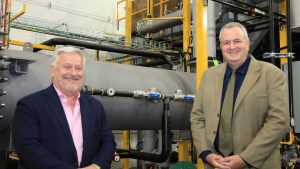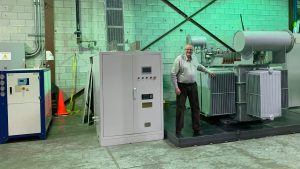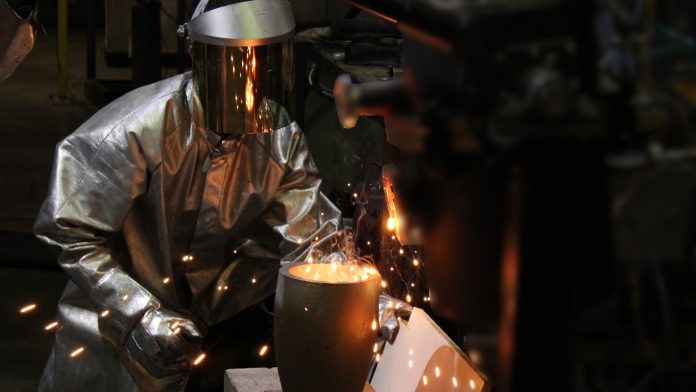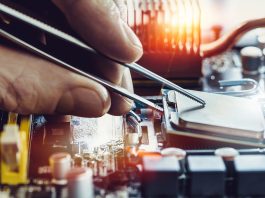The Innovation Platform spoke to Bernard Tourillon, Chairman, President and CEO of HPQ Silicon, to find out more about the company’s plans to manufacture high-value silicon and silica-based technologies.
HPQ Silicon is a Quebec-based innovative technology development company offering silicon (Si) and silica (SiO2)-based technologies. With ambition at its core, HPQ is set to hit major milestones in the year to come on its journey to develop a unique portfolio of high value-added silicon (Si) products sought after by battery and electric vehicle manufacturers.
To find out more about the company, its goals, and plans for the future, The Innovation Platform spoke to HPQ’s Chairman, President and CEO, Bernard Tourillon.
Can you tell us more about HPQ Silicon? What are your key objectives, and what are your current focuses?
In collaboration with world-class technology partners, such as PyroGenesis Canada Inc., HPQ’s key objective is to demonstrate its unique capacity to be a low-cost and low-emissions producer of high-purity and value-added silicon materials such as silicon nanopowders and nanowires needed for the manufacturing of next-generation lithium-ion batteries for use in electric vehicles (EVs), and other advanced silicon metal materials required in the production of silicones and aluminium alloys.
To achieve this, HPQ currently focuses on developing three projects based on the diverse applications of its technology.
Firstly, the company is developing its proprietary PUREVAP™ Quartz Reduction Reactor (QRR). This innovative process will enable a one-step transformation of quartz (SiO2) into high-purity silicon at a reduced cost, with low energy use and low carbon footprint.
Secondly, it is developing a new proprietary process (PUREVAP Nano Silicon Reactor (NSiR)) that can use material produced by the QRR as feedstock to make a wide range of nano/micro spherical powders of different sizes and nanowires.
Lastly, the company is developing a new proprietary plasma-based process that will allow a direct ‘quartz to fumed silica’ transformation. This unique process avoids using hazardous chemicals in fumed silica production and eliminates the production of hydrogen chloride gas (HCI) as a by-product usually associated with its manufacturing.

What role can silicon nanomaterials play in the renewable energy revolution?
The rapid development of nanomaterials has opened up new avenues for converting and utilising renewable energy. Silicon nanomaterials represent a prodigious opportunity for the renewable energy revolution.
The unique traits that define silicon nanomaterials are particularly effective when incorporated into solar energy cells, lithium-ion batteries, and micro and integrated semiconductors. These silica-based technologies are necessary products that will help accelerate the goal to reach net-zero emissions and total electrification in this century.
When converting sunlight into an electrical voltage, there is lost efficiency, reducing savings and leading to higher costs. There is also direct optical loss, where between 2% and 10% of incoming sunlight is reflected into the atmosphere. Silicon nanostructures have the potential to solve both these problems.
Being only several hundred nanometres in size (much smaller than is visible to the human eye), silicon nanomaterials create an interface between the air and the structure and become graded rather than planar. This design improves solar photovoltaic cell technology as it enables sunlight to be precisely absorbed, reducing reflection and increasing the overall efficiency of solar cells.
Nanomaterials play a vital role in revolutionising lithium-ion batteries – which in their current state will not be able to meet the demands of the future. Considered one of the key material inputs to reduce carbon emissions in the energy, transportation, and industrial sectors, nano silica-based technologies offers a way to develop advanced and high-performance batteries in an exceedingly efficient, safe, and scalable manner.
With more than ten times the theoretical capacity of traditional graphite battery anodes, silicon nanomaterials could boost lithium-ion battery capacity by 100-200%. Though managing the stability of nano silicon anode batteries still poses a challenge to researchers, the potential for silicon to fundamentally transform the global cleantech market is unrivalled.
How is your company positioned to meet an increase in demand for silicon nanomaterials?
While silicon nanomaterials are most often discussed in renewable energy and other clean technologies, they are prevalent in several industries. It is this diverse applicability that is lending itself to the dramatic growth currently being experienced in the nanomaterial industry.
End-use demand for silicon nanomaterials is reaching new heights, thus pushing the value of the silicon materials market ever higher. Between 2022 and 2029, forecasts predict a compound annual growth rate (CAGR) of 7.21% – outcompeting many other industries.
In addition to offering a range of new, cross-industry solutions for the private sector to capitalise on, other beneficiaries of silicon nanomaterial growth include Brazil, Norway, and the United States – the largest producers of the material in the world.
The recent surge in attention paid to silicon nanomaterials demonstrates their recognised profitability. Society will fundamentally re-orient itself around two critical factors, technology and sustainability, in the coming decades. In addition, silicon nanomaterials look to hold the key needed to usher in this transformation: researchers certainly seem to think so.
Having patented proprietary scalable and low emissions silicon-material-producing technology such as the PUREVAP sets the stage for HPQ to scale as needed, to fulfil growing demand quickly. The company’s strategic location of Montreal in North America adds another advantage in that it is close to the end-user, decreasing transportation costs and eliminating international supply chain disruptions that often plague the logistics sector.
What is the potential of silicon for use in disruptive technology?
As the second most common element on the planet, silicon (Si) is an incredibly abundant resource. Like all other energy metals (lithium, graphite, cobalt, nickel, etc.), it does not exist in its pure state and is expensive to extract.
More commonly, purified silicon metal is produced by refining silica, which is a combination of minerals (mainly quartz) combined with oxygen. Once silicon metal is produced, specific characteristics – such as its semi-conductive status, high melting point, and strength – allow it to be used in various industrial processes.
The massive global silicon market can be attributed to the diversity of products silicon is a major component of – as well as its potential in disruptive technologies.
The European Union declared silicon a critical raw material as a wide range of modern silica-based technologies depend on it to make industrial and consumer products, including glass, aluminium, automotive alloys, silicones, microchips, and photovoltaic solar panels. All these everyday products ensure a robust and growing demand for the metal. That is why confidence in the silicon market will remain high, as varying industry trends indicate that demand for the material will reach 3.8 million tonnes in the coming years.
The automotive industry is trending toward smaller, lighter, and electric cars to increase fuel efficiency and reduce emissions. This bodes well for the silicon market, as silumin – a combination of aluminum and silicon – is relatively light and can be used to replace heavy cast iron and steel car components.
High-end electronics are reliant on silicon. Microcomputer chips are used for the fabrication of integrated circuits. As the electronics market grows, so will the demand for silicon metal.
Ferroglobe’s fourth quarter and annual 2021 earnings call reported remarkable growth in the index for silicon metal – which increased by approximately 160% – to end the year slightly above $10,000 per tonne. The intra-quarter peak pricing was €8,100 and closed out at €6,100 – constituting a 53% increase over the quarter.
Such a dramatic rise in silicon metal pricing is attributed to a combination of factors, including widespread expectations of impending production limitations in China (continuing throughout the final months of the year), as well as continued growth in end-of-market demand. Additionally, Chinese silicon production, which is among the dirtiest in the world, is facing a series of financial and environmental reforms – the result of which have increased labour, logistics, material input, and energy costs.
Silicon nanomaterials – a silicon metal derivative popularly used in computer technology, health and medicine, construction, and sustainable energy production – are considered the ‘next big thing’. Whilst the uses for silicon nanomaterials are pretty varied, the general focus has been on renewable energy and battery applications due to their high energy density. As EVs continue to gain traction, consumers demand faster charging times, longer ranges, and greater reliability. These aspects are addressed by adding silicon nanomaterials to lithium-ion battery anodes.

Several research teams have now successfully developed durable batteries using silicon nanomaterials – with double the energy capacity of existing graphite anodes. Once profitable economies of scale are reached, EVs and other electric transit methods will become far more ubiquitous. Not to mention the energy storage applications, which could further speed up electrification.
Solar panel efficiency is directly linked to how much irradiation is captured and converted into electrical energy. High-performance silicon cells have a maximum theoretical limit of 29.3% in their current form; silicon nanomaterials, however, can boost perovskite-based panel efficiency (by as much as 19%) by trapping a broader range of light wavelengths.
High-purity silicon metal and nanomaterials will power a wide range of cleantech innovations guaranteed to disrupt contemporary practices – in a good way. Efficiency in technology design is essential to profitability and sustainability, and silicon nanomaterials highlight this demonstrably.
How do your recent investments align with your own strategic goals and overall sustainability goals?
HPQ’s unique advantage is its ability to apply leading technological solutions to contemporary Environmental, Social, and Governance (ESG) challenges to create synergy between the company’s sustainability goals and its economic performance.
HPQ’s one-step PUREVAP Quartz Reduction Reactor (QRR) technology to develop high-purity silicon metal enables a marked reduction in energy inputs and carbon emissions while producing financial savings. Whereas traditional processes require 6.5MT of raw material to produce 1MT of silicon, HPQ’s process only requires 4.5MT – a 25% input cut that offers up to a 20% cash cost advantage. Simply put, HPQ’s technological applications are a win for the environment and investors.
Based out of Quebec, an abundance of cheap, clean, and renewable hydroelectricity powers HPQ’s highly efficient operations. This is in stark contrast to the bulk of silicon production, which relies on hydrocarbon fuels in less regulated jurisdictions. As HPQ operates, sources materials, and manufacturers out of North America, there is also no need for cross-world shipping, representing roughly 3% of all global emissions. Localised production demonstrates HPQ’s social commitment to the communities it serves, but it reduces Scope 3 emissions – the scope most often ignored – by a significant margin.
HPQ has invested close to $10 million in developing the PUREVAP technology. The company is committed to investing at least $1 million in developing its nanotechnologies, which will enable the production of the silicon nanomaterials needed for diverse industry applications. HPQ has also invested in green, electrolysis-based hydrogen to further its commitment to fostering sustainable, technological, and scalable solutions.
HPQ’s commitment to sustainability is real – and it intends to do its part to address climate change and other contemporary problems – while growing its portfolio of high-end silicon and nano silicon solutions.
HPQ has started exploring hydrogen-based ventures. Can you elaborate on what these are, the progress made in this exploration process, and how they could complement your silicon/silica projects?
HPQ is looking at two hydrogen-based ventures, of which one could be complementary to its manufacturing process. At the same time, the other could be an additional downstream market for its produced silicon nanomaterial.
The first complementary venture is looking at a highly efficient electrolysis process to generate hydrogen that could eventually be used to generate the enormous power needed for internal operations and run the company’s manufacturing plants. The second venture, which could be an additional market opportunity, is an offshoot of the company’s silicon technology, exploring the use of silicon nanoparticles to manufacture hydrogen anywhere around the world. The technology works by combining silicon nanoparticles with water to extract hydrogen through hydrolysis.
HPQ is in the very early stages of the hydrogen ventures. The company is validating the technology from a third-party provider for its electrolysis technology.
For the silicon nanoparticles venture, the company is in the conceptual phase. It will need first to validate its unique capacity to produce low-cost nanomaterials to make the hydrolysis process economical. Currently, producing silicon nanomaterials is technologically feasible but expensive and not economically viable. HPQ is working towards validating its approach to make it doable by using its nanoreactor technology.
HPQ’s hydrogen-based ventures complement its silicon/silica projects. One of them is an additional downstream market, as previously mentioned, and the other would help the company effectively attain its ESG objectives concerning energy use.
What are your plans for the next 12 months and beyond?
The following 12 months are going to be very exciting for HPQ.
The company’s pilot plant for its QRR technology will be operational during the next 12 months, and the data collected will inform the process of developing its first commercial plant. The company will also advance its nanoreactor development from GEN1, bench test, to commercial scalability pilot plant proof.
The company should also complete its fumed silica project’s engineering, construction and commissioning, with the pilot plant set to be operational in 2023. It would start shipping material samples to potential end buyers by this time.
The company’s hydrogen ventures will also be developed in parallel.
Please note, this article will also appear in the tenth edition of our quarterly publication









